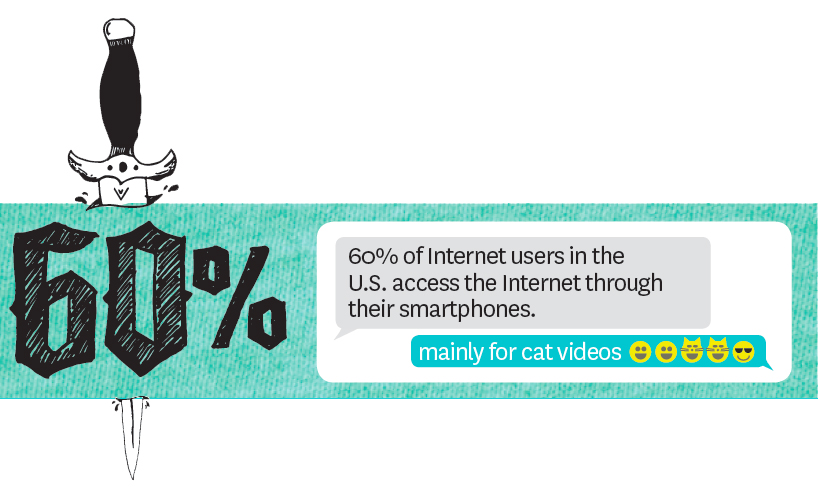November 29th, 2015
“One Metric” – The Holy Grail?
The Advertising Age article, One Marketing Metric to Rule Them All? Group Believes It Has One is if not the latest, one of many recent pieces published about some of the wonders new technology and media can offer: increasingly precise and real-time measurements of the impact of marketing and advertising initiatives.
October 28th, 2015
The Future of Computers is Wearable
Wearable usage will grow by nearly 60% this year. That’s an impressive number considering that just a couple short years ago the term “wearable” was an overhyped buzzword with little practical applications outside of the Fitbit products. Google glasses were downright weird (personal opinion) and few of us had the interest (or guts) to walk around in them. Read More
October 26th, 2015
What’s the Newest in Marketing to Emotions?
It’s interesting to me that the words “emotion”, “marketing” and “customers” are finding themselves together in what seems to be increased frequency over the past few months. Read More
September 10th, 2015
Jared Fogle, You Didn’t Just Let Subway Down
Subway was very smart. When they realized that a kind of nerdy, overweight college kid used their food to lose weight, they made him their brand ambassador. Jared Fogle spoke for the people, to the people; and he made Subway into a healthy alternative.

It doesn’t get better than that for a brand. A real-life, testimonial that elevated their brand and made millions for them – and they didn’t really have to try.
We were all excited and encouraged by Jared’s success. If he could do it – so could we! He was a shining example to many.
Jared’s recent imprisonment for sexually-related criminal behavior of various kinds was a bit of a black eye on the clean-cut Subway spokesperson, and indirectly on the Subway brand. Wow, no one saw that coming! From recent accounts, Subway’s not handling it all that well. Although Jared’s behavior is clearly not a direct reflection on the brand, a little more concern from Subway execs – who seem to be brushing it off like yesterday’s lint – might be in order.
The really sad thing here – aside from the poor families victimized by Fogle – is the damage done to all the other brand ambassadors. Will any of them ever really be trusted from this time forward? I think you know I’m talking to you, Jake, from State Farm!
September 8th, 2015
Building Brand Loyalty – No Longer about “Keeping up with the Joneses”
Are the Joneses feeling overlooked these days?
The 2nd-quarter issue of our newsletter, THINKING, leads off with this article: Great Expectations – Understanding the Consumer’s Mindset in Order to Generate Brand Loyalty.
I’ve been in the industry longer than I care to admit and long enough to appreciate a shift in who drives the brand relationship. Taking a moment to reflect on the past has two purposes:
- For the sake of comparison.
- To dislodge a 1980-something concept of building brand loyalty, if any still try to rely on it.
And speaking of twos, these lines from the article in particular leapt out at me:
- “Where marketing was previously about mass media channels, we must now think of everything as a channel.”
- “More important than ever-changing channels and mediums is the mindset of the consumer.”
Recalling efforts to build brand loyalty earlier in my career, marketing was about mass media channels and much more. Positioning reigned, and mass media was kind of all there was. We worked diligently to develop affinity for brands that would enable consumers to “fit in” with people they admired. The effort was probably more about creating loyalty to brands that actually had our consumers feeling a few steps ahead of the Joneses, rather than just keeping up.
MarketingProfs issued an article earlier this year that said it succinctly: “The segmentation methods of yesteryear (demographic, geographic and psychographic) created a language about customers that was rooted in brand value—not personal value.”
Where building brand loyalty could be achieved in the past by enabling consumers to feel part of THE crowd, it’s now engagement at a much more personal level. This takes understanding and connecting with consumers at the “mindset” level.
Read Great Expectations for insight on “Six Integrated Mindsets”. I hope these ideas are helpful starting points as you approach loyalty building strategies in the months ahead.
July 26th, 2015
The Heartbeat of Innovation –
Do you feel that pulse?!
It may be the bias of my passion for the marketing and advertising business that drives me to enthuse about the innovation – or at least the potential to innovate – that is at the heart of it.
New product development, restaging a dated product, generating brilliant and breakthrough creative, discovering new markets, and so many more opportunities to innovate: the possibility for building something truly novel is a rush, isn’t it?
A recent Forbes article about Lexus developing the prototype of a Hoverboard caught my innovation-loving attention. And it prompted some questions:
- How good are organizations really in their ability to innovate?
- What innovations that could be solutions to serious problems might be gathering dust in organizations across the country? Around the world?
The Lexus Hoverboard: this is a product concept that grabs the imagination, doesn’t it?
From the Jetsons to Back to the Future, the concept may not be new, but Lexus has a prototype. That seems pretty gutsy. How many organizations will invest the resources and take the risk to develop a product that is so “out there”?
“At Lexus, we constantly challenge ourselves and our partners to push the boundaries of what is possible. That determination, combined with our passion and expertise for design and innovation, is what led us to take on the Hoverboard project. It’s the perfect example of the amazing things that can be achieved when you combine technology, design and imagination.”
These are words of inspiration… “Push the boundaries”…“Passion”…”Combine Technology Design and Imagination”…and it’s my sense anyway that we see and hear them a lot.
It may be silly to ask how many companies express words like these and then also put them into action. How many Hoverboard prototypes do you see?
One answer may be in a survey The Center for Creative Leadership conducted with its 500-client panel in 2014 about the need they see for innovation and their ability to deliver it:
- 94% of respondents said innovation is a key driver of success.
- Only 14% felt confident about the ability of their organization to drive innovation effectively.
Also of interest, the Association for Talent Development recently published an article, Stuck in the Middle: Why Innovation Dies and What to Do About It. If creativity might be getting stuck in your organization, look at some of the ideas it offers for letting innovation break free.
July 8th, 2015
Dear Facebook
I would like to ask you for a favor.
I use Facebook for business, for personal connections and for book promotion. I used to look forward to checking out my News Feed for all the interesting, entertaining and sometimes even exciting posts. Now I approach with trepidation. There are things I see that turn my blood cold. Some of these things have a major, negative impact on my state of mind, and I can ill afford to have that happen. Call me a wimp if you want – but I know for a fact that I am not alone in this perception.
Let me give you some examples. For me, the single worst thing that occurs with a great deal of frequency is when folks post stories and photos of atrocities to animals, and even to humans. I know they are meant to make me aware and propel me into action, but they horrify and upset me. In that state I’m rarely good to anyone – for anything. My second biggest concern is all the folks who post that their dog or cat has died. I am an empathetic person – this just kills me. Two nights ago, I saw tearjerking posts about four different French Bulldogs that had died. My heart goes out to them – too far out. These posts can ruin my whole mood. Does that seem selfish? Well, I have my own mood-ruining stuff – so I don’t need to share everyone else’s!
Second tier aggravations are political and religious posts. If I agree with you I don’t need to read it and if I don’t, you’re not going to convert me – so I don’t want to see it. I’ll never be impressed with your religious or political opinions because they are personal opinions that you are entitled to have, but I’m not obligated to be subjected to them.
Aside from these 4 major problems, there are a just a few more irritating areas: folks who drop vague hints in order to be drawn out – just say it for god sake, folks who oversell – I’m okay with a little light sell – but some of these folks need to give it a rest and lately I’ve been getting an influx of posts selling erotic reading material – I can’t reject those eroto-posterbaters fast enough. And what’s with those videos that you click on, only to be diverted to some hideous photo that shocks and horrifies? Please, no more photos of botched surgery in vivid color, I can only take so much!
After all of this, here’s the favor. Could you please start to compartmentalize some of these topics out of the mainstream News Feed? I would even pay money not to see the atrocities and the dead pet announcements.
I would never suggest that these folks don’t have the right of free speech – or posts – but they are impinging on my right not to be traumatized. There’s got to be a way, maybe a separate News Feed for Rainbow Bridge or a social consciousness news feed. Let’s face it, the whole political thing is only going to get worse in the next year.
If you compartmentalize these posts I can decide to engage when and if I choose, and my Facebook experience will improve exponentially. How about it – can you help me out here?
June 18th, 2015
Thinking: It’s a Two-Way Street
When I first started in this business some 30 years ago, we spent a lot of time in upfront planning and strategy to understand consumer needs, wants and behavior, but once the campaign launched, 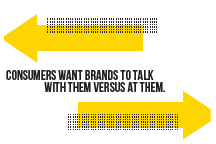 it was pretty much ‘set it and forget it.’ The tools of that time were fewer and they were one way. So we marketers formed our messages, and it was pretty much a monologue. Today, not so much. Transition from monologue to dialogue.
it was pretty much ‘set it and forget it.’ The tools of that time were fewer and they were one way. So we marketers formed our messages, and it was pretty much a monologue. Today, not so much. Transition from monologue to dialogue.
Not only is there significantly more media fragmentation, more access to data, and 100 times the number of options to reach consumers, but also (and most importantly) the Internet has shifted the power dynamic from marketers to consumers – specifically Web 2.0.
With just a click of a button, consumers can access data from around the world to gain meaningful insights about companies and their products. They can compare products, find lower prices, read reviews and even communicate with other users about product quality and buyer satisfaction.

Iterative planning and execution have become the norm.
While we still do smart planning with a lot better tools at our disposal, the launch of a campaign today is just the beginning. As marketers, we need to monitor conversations, track sentiment, gauge behaviors and assess ongoing performance. And we must optimize or change our efforts on the fly. Overall, each marketing plan and execution has become more iterative.
Beware: consumers can easily disengage.
Contrary to what some would have you believe, traditional media, like TV, radio and print, are not dead. But you can no longer count on traditional advertising alone to capture and keep attention. You need to be where your audience is, with a compelling message that sparks conversation and engagement. And it’s not easy to engage more deeply with consumers when they have the power to so easily disengage.
Find the right place, time and message.
Being at the ‘right place at the right time with the right message’ has always been the goal of marketers. And today, with the wealth of data at our fingertips, we have the ability to do just that. When consumers make brand contact, they seek true one-to-one engagement versus simply a barrage of one-way marketing messages. Consumers want brands to talk with them versus at them. They seek a variety of messaging through a variety of channels that paint a consistent picture of the brand experience you offer.
Consumers can sniff out manipulation a mile away.
Consumers have become increasingly resistant to feeling manipulated, and they will make their views widely known. They will quickly sniff you out if they believe you are using them only for your own benefit, or if something is not authentic. Case in point, recently Starbucks launched the #RaceTogether initiative, which was the company’s diversity and racial equality campaign. While the intent may have been good, the execution was not. And after just one week, and a ton of negative backlash, the effort was pulled.
The more things change, the more the key marketing principles endure.
While the tools of the trade have changed dramatically, and technology will be ever-evolving, the fact is that the basic tenants of marketing hold constant against the odds of change.
Information overload. We need to work hard to give relevant meaning and appropriate context in order to retain the attention of our audience.
 People buy a feeling. The best branding inseparably integrates itself with the consumer’s lifestyle.
People buy a feeling. The best branding inseparably integrates itself with the consumer’s lifestyle.
Existing customers are pure gold. When you engage buyers in the right manner to remind them why they spent money with you in the first place, your company stands an excellent chance of earning a repeat sale.
Creativity is king. Being truly creative is the only way to stand out from the crowd.
Sound marketing planning and strategy helps you succeed. Information is powerful, and building a good marketing strategy starts with understanding the external factors that will affect your business.
June 18th, 2015
Thinking: Back to Basics
The four fundamental rules of advertising – then and now.
AMC’s “Mad Men” has come to a close, but our fasciation with the era – known as the Creative Revolution in advertising – remains.
As a fan of the show, it’s easy to marvel at how antiquated some of the ideas and practices seem. Women in power were a novelty in the Mad Men era; today, I work for a 100% woman-owned agency. The show’s Sterling Cooper and other ad agencies earned their incomes from 15% media commissions; today, most of our clients are fee-based, or, in a few progressive cases, performance-based. Don Draper dismisses research; today’s creative professionals relish it.
But when you step back, the fundamentals of advertising haven’t really changed at all.
In this current advertising era, there seems to be a mad rush to get to the new and dismiss the old. We’re always trying to chase the bright, shiny new object. And because of that, we tend to lose sight on the cornerstone of what makes this industry work. So here are four basic fundamentals of advertising that worked in the past and you should still follow today.
Understand your audience.
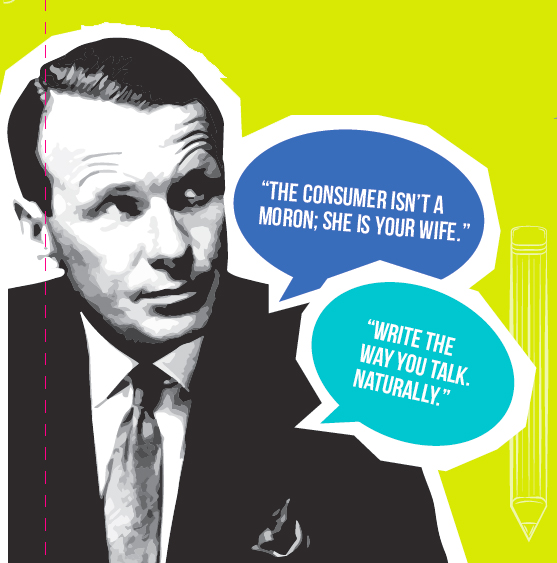 When it comes to this fundamental, I say look to the patron of advertising for guidance: David Ogilvy. There are two Ogilvy rules of thumb you should always remember. The first is to give your audience the credit they deserve. Ogilvy says, “The consumer isn’t a moron; she is your wife.” A little sexist sounding now, admittedly, but the sentiment is still there. To be successful in this industry, respecting the consumer’s intelligence is a must. The second rule of thumb is to do your homework. Ogilvy believed that “if you don’t know who you’re writing for, you’ll just be faking it, and that will lead to more problems than you can imagine.” So get to know your audience – understand how they think and what they need.
When it comes to this fundamental, I say look to the patron of advertising for guidance: David Ogilvy. There are two Ogilvy rules of thumb you should always remember. The first is to give your audience the credit they deserve. Ogilvy says, “The consumer isn’t a moron; she is your wife.” A little sexist sounding now, admittedly, but the sentiment is still there. To be successful in this industry, respecting the consumer’s intelligence is a must. The second rule of thumb is to do your homework. Ogilvy believed that “if you don’t know who you’re writing for, you’ll just be faking it, and that will lead to more problems than you can imagine.” So get to know your audience – understand how they think and what they need.
Speak the truth.
The sad truth is, people don’t trust advertising anymore. In 1912, the founders of McCann Erickson started their agency on the motto “Truth Well Told” – a credo that, if applied appropriately, can still lead to some of the most effective advertising. Take Bill Bernbach’s iconic “Think Small” campaign for example, where Volkswagen took a seemingly negative product (a “small” vehicle) and paralleled it to positives (“small insurance” and a “small repair bill” and so on). Or the Avis “We Try Harder” campaign, where they took the simple truth of being ranked second in the industry and turned that into a reason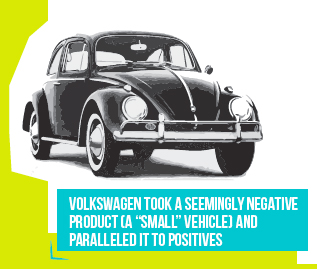 (or rather, a vow) to try harder for the consumer. Both were successfully truthful campaigns, and both are approaches that can still work today. Remember, it’s okay to have a little humility and self-deprecation. It’s disarming. So, rather than trying to fabricate something, highlight the truths and relate those to the audience and their needs/desires.
(or rather, a vow) to try harder for the consumer. Both were successfully truthful campaigns, and both are approaches that can still work today. Remember, it’s okay to have a little humility and self-deprecation. It’s disarming. So, rather than trying to fabricate something, highlight the truths and relate those to the audience and their needs/desires.
Make things connect.
Don’t yell at people. And don’t talk over people’s heads. I turn to Ogilvy’s advice yet again: “Write the way you talk. Naturally.” Let me give you an example. Imagine walking into a car dealership and the dealer says to you in a slow, commanding voice, “Speed. Power. Performance. That’s what you’re looking for in an experience.” You’d think he was nuts. Because that’s not how people talk. The same goes for your advertising. Talk to them directly. And remember the first two fundamental rules while you’re at it: connect with them on a level that includes respect and honesty.
Be relevant.
At its core, advertising is about gaining attention and interest of an otherwise disinterested audience. How many times have you heard people say, “Nobody reads ads”? Well Howard Gossage, an advertising icon during the “Mad Men” era, said it best, “People read what interests them, and sometimes that’s an ad.” If what you’re putting out there is relevant to someone, they’ll pay attention. It’s just that simple. But that’s why it’s so important to make someone curious enough to stay engaged – and why knowing your audience’s needs and wants from the get-go will help you tremendously in the long run.
Just because it may have seemed groundbreaking in the past and old hat now, doesn’t mean the basic fundamentals of advertising should be forgotten. There’s so much gold there that we’re dismissing. It’s still relevant today. In fact, it’s pertinent. So take it from the greats and get back to the basics.
June 18th, 2015
Thinking: Mobile or Die
When Apple’s first iPhone was announced in what is a now a seemingly distant summer of 2007, we entered a new era of mobile computing. A 3.5-inch (large-for-its-time) screen let users access and experience content on their phones in an entirely novel way – touching it. A method of input so natural that today we take it for granted. As the years went on and the ecosystem grew with the market, the hot mobile experience du jour did, as well. First, there were dedicated mobile sites, then (and still) apps, and now, here in 2015, we find ourselves with a trend that has arguably transcended to convention: responsive Web design.
Responsive design is the name given to a programming technique that allows your site to automatically adjust its layout to one best suited for the device you’re on. On a computer? The site fills the screen. On your phone? The site adjusts down to size – in a way that is still user-friendly. If you’ve used the Internet on your phone at all in the last two years, there’s almost no chance you haven’t used a responsive site.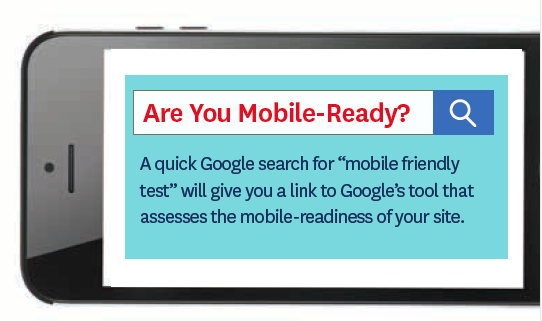 The idea makes so much sense. Why maintain multiple websites when I can maintain one? Responsive is also attractive in that an existing site can be retrofitted to be mobile-optimized without needing to redo the backend (and all the headache that can come with it).
The idea makes so much sense. Why maintain multiple websites when I can maintain one? Responsive is also attractive in that an existing site can be retrofitted to be mobile-optimized without needing to redo the backend (and all the headache that can come with it).
For the last few years, mobile optimization has been encouraged, but it was often hard to justify as a requirement. After all, people could find you in their searches just fine. Worst case was they may have to pinch and zoom around your site. As of April 2015, however, the worst case for not being mobile-optimized is your potential audience won’t even get a chance to see your website – because you will no longer appear (as prominently) in organic search results. Google made the decision to give mobile-optimized sites preferred ranking over non-mobile peers. … If you’re sweating about your site right now, don’t worry; you aren’t alone. This “mobile preference” is projected to affect the rankings of approximately 40 percent of the websites Google has indexed.
In this one outwardly simple change to how Google ranks websites, they have sounded a very clear decree. The mobile Web isn’t a trend or fad; its here to stay. To be digitally competitive, you have to be mobile-optimized, and responsive design is a great means to this end – but not the only one. Dedicated mobile websites are by no means dead and are in use on prominent Web presences. Neither is right or wrong, just a different tool, depending on the job. This being said, using responsive design for mobile optimization has become the defacto standard. A dedicated mobile site should only be considered if there are significant technical reasons why responsive would be neither possible nor practical.
Fifteen years ago, after we collectively got over worrying about Y2K, people actually debated whether the Internet was a fad or not. Today, nearly half the world’s population has access to the Internet – that’s a 741.0 percent increase over the same time. In the U.S. in particular, nearly everyone has access to the Internet (9 out of 10) – and 60 percent of the time they are accessing it through their phones. The desktop experience, of course, remains relevant, but mobile usage has reached a threshold that is too great to ignore.
If your business isn’t currently offering your mobile users an optimized browsing experience, it is time to start planning to offer them one. If you don’t, by this time next year, you might not have a mobile audience to be worrying about.
